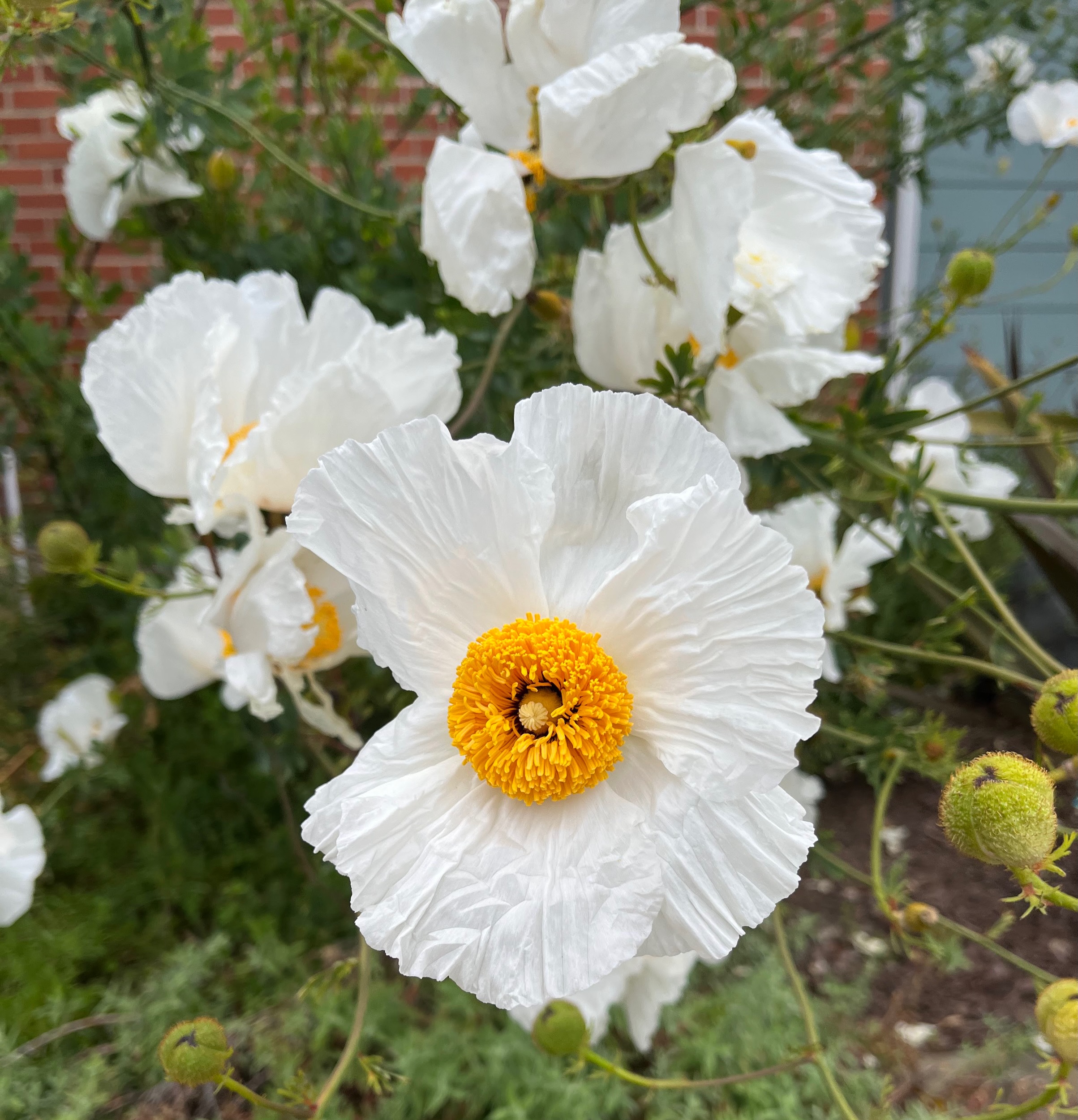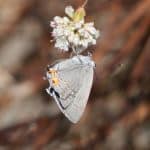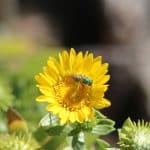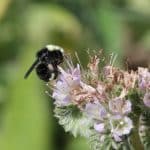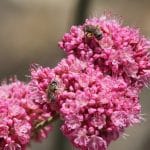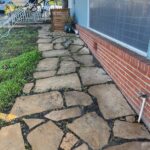NOTE: The stones in the back garden path are uneven; please watch your step on them, and also be careful going up the steps that lead up to the seating area.
Showcase Feature
This charming garden contains a plethora of eye-pleasing features, from the native grape that climbs the trellis at the entryway to the house, to the cream-colored flowers of the buckwheats that mingle with the purple of the sweetly scented sages, and the wildflower meadow that brightens an area formerly encased in ivy. The child-friendly back garden contains two paths surrounded by native groundcovers (Lippia, yarrow, and Yerba buena) that lead to a hardscaped play area on one end and a solar-pump-powered fountain on the other.
 In order to reduce fire risk (and get their insurance renewed!), hardscaping was added 5′ around the perimeter of the house – at Zone 0 – see the last thumbnail photo at the bottom of this page. The path was newly-installed when this photo was taken. Check out the new flagstone path near the heat pump compressor on the side of the house. In addition, many trees were removed, including a large native, but fire-prone, juniper. The native oak tree remains, as oaks are generally considered fire-resistant—but it was artfully pruned so that no branches droop onto the roof.
In order to reduce fire risk (and get their insurance renewed!), hardscaping was added 5′ around the perimeter of the house – at Zone 0 – see the last thumbnail photo at the bottom of this page. The path was newly-installed when this photo was taken. Check out the new flagstone path near the heat pump compressor on the side of the house. In addition, many trees were removed, including a large native, but fire-prone, juniper. The native oak tree remains, as oaks are generally considered fire-resistant—but it was artfully pruned so that no branches droop onto the roof.
The back garden was designed and installed by Miri Malmquist, owner of Beauty and the Feast; the front garden was designed by Sallie Bryan, owner of 4B Garden Design, and installed by Pamela, her mom, and a gardener.
Free native plant seeds will be offered (while they last). Take a seat at the dining table on the patio and enjoy this charming space; you won’t want to leave.
Other Garden Attractions
• Charcoal-colored CollideEscape screening was installed on the picture windows to prevent bird /glass collisions.
• Invasive Mexican feather grass was removed—see this information from Plant Right to find out why you should take yours out, too, if you have this plant in your garden.
• In order to retain rainwater onsite the downspouts drain into the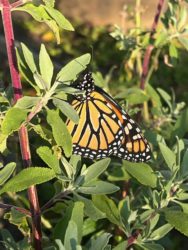 garden. This keeps plants green longer, protects the local creek from scouring, and replenishes the aquifer.
garden. This keeps plants green longer, protects the local creek from scouring, and replenishes the aquifer.
• In the front garden a dry stacked retaining wall and large boulders provide visual interest.
• Check out the two Little Free Libraries—the tall one for adults, and the short one for children.
Gardening for Wildlife
The plants in this garden were selected because they were useful to bees and other pollinators, or people. (There is a small veggie garden in the back.) Monarch and swallowtail butterflies reproduce in this garden; check out the displayed photos of past caterpillars, and ask Pamela to see a chrysalis remnant.
Native bees nest in the ground in the back garden. White-lined sphinx moths, also called the “hummingbird moth” lay their eggs on the clarkia in Pamela’s garden, and their amazingly beautiful caterpillars (see the 4th photo in the set of thumbnails) graze on it. A bee house, bird house, and the cavities in the rock wall create homes for additional creatures.
Keystone species (watch this talk by Doug Tallamy!)
Keystone species—our own, local ecological powerhouse plants— in this garden include currant, California lilac, lupine, aster, manzanita, buckwheat, native strawberry, sages, cream bush, elderberry, coyote brush, coffee berry, and penstemon.
Green Home Features
Pamela and her husband have installed a Frigidaire induction range, and a ducted heat pump system for heating and cooling the house. Prior to having the heat pump installed an energy audit was performed and insulation was installed in the attic. Pamela reports that the insulation “made a tremendous difference in keeping the house cooler in the summer; it has been wonderful having the air conditioner when it has been hot; and the filter that comes with the heat pump has kept the indoor air clean on smoky days.”
At least partially wheelchair accessible? yes
Photos
Click to see as a slideshow:

